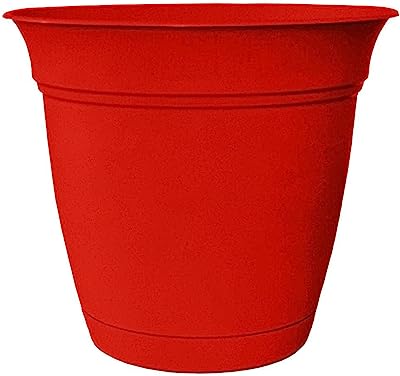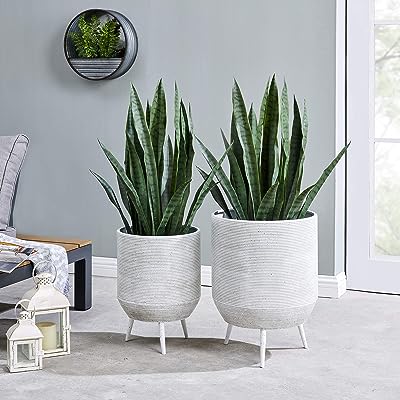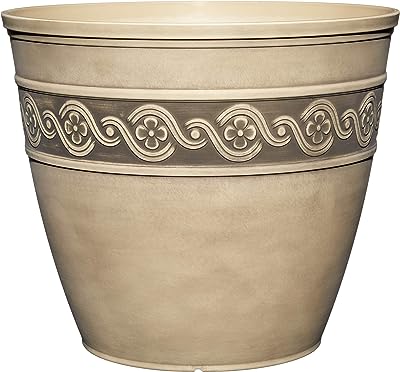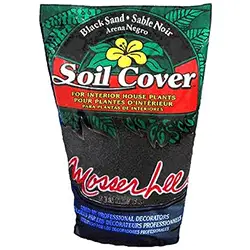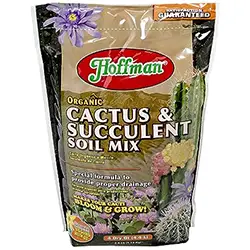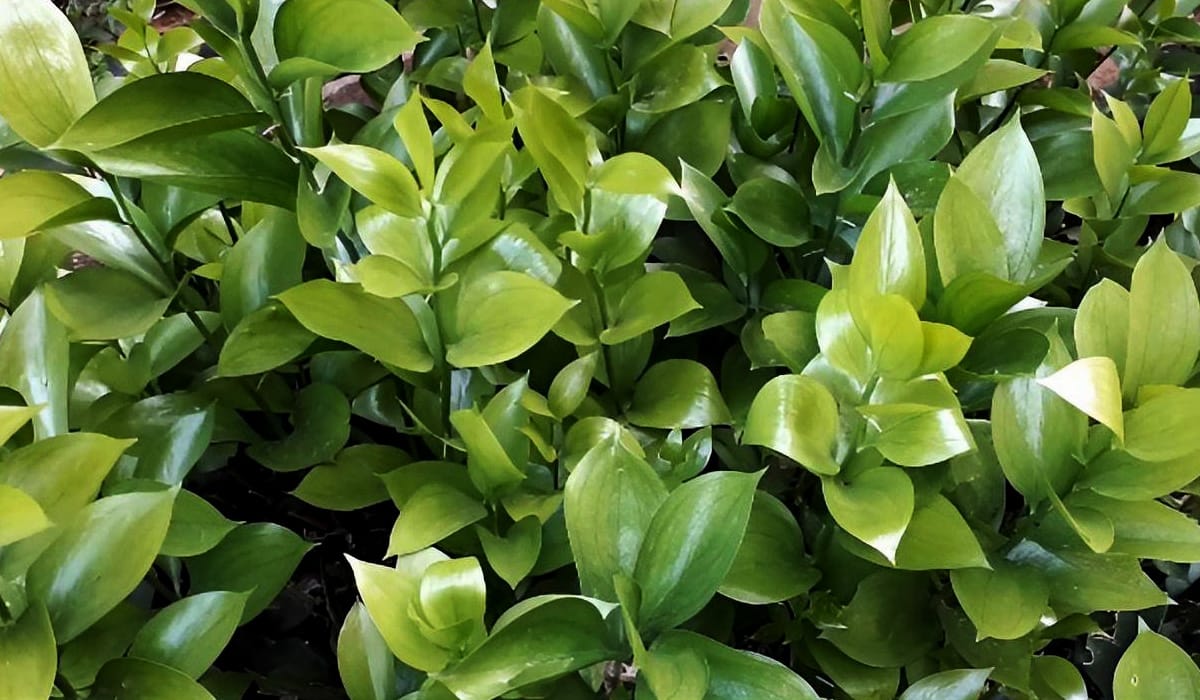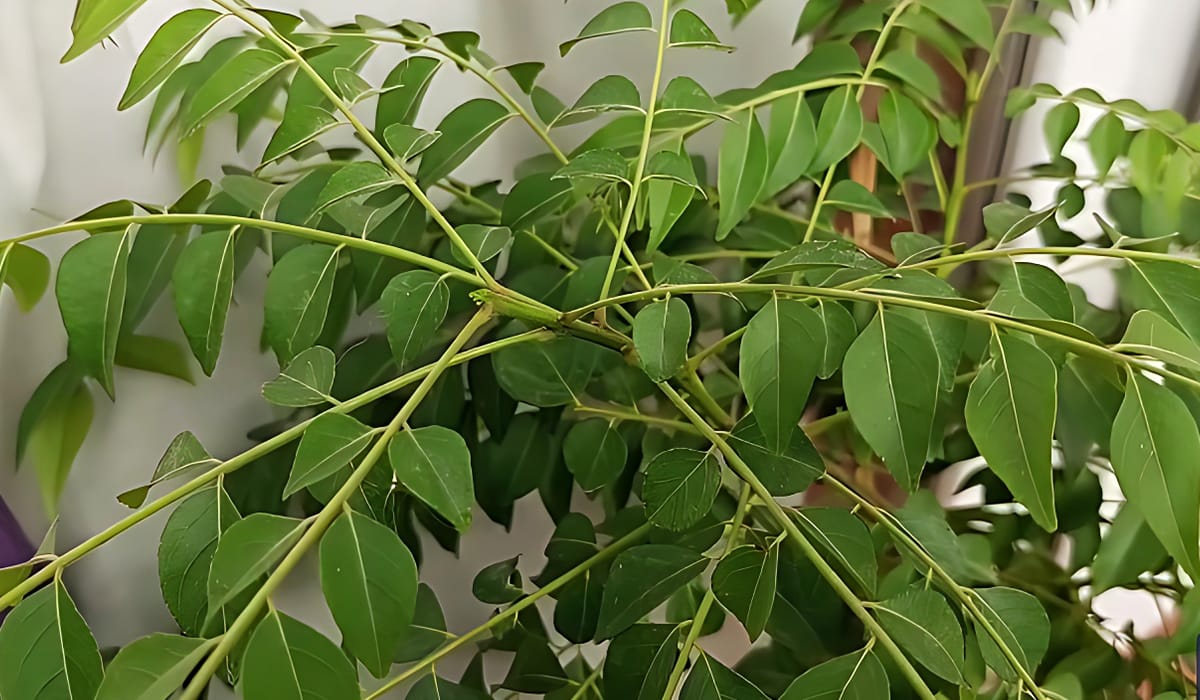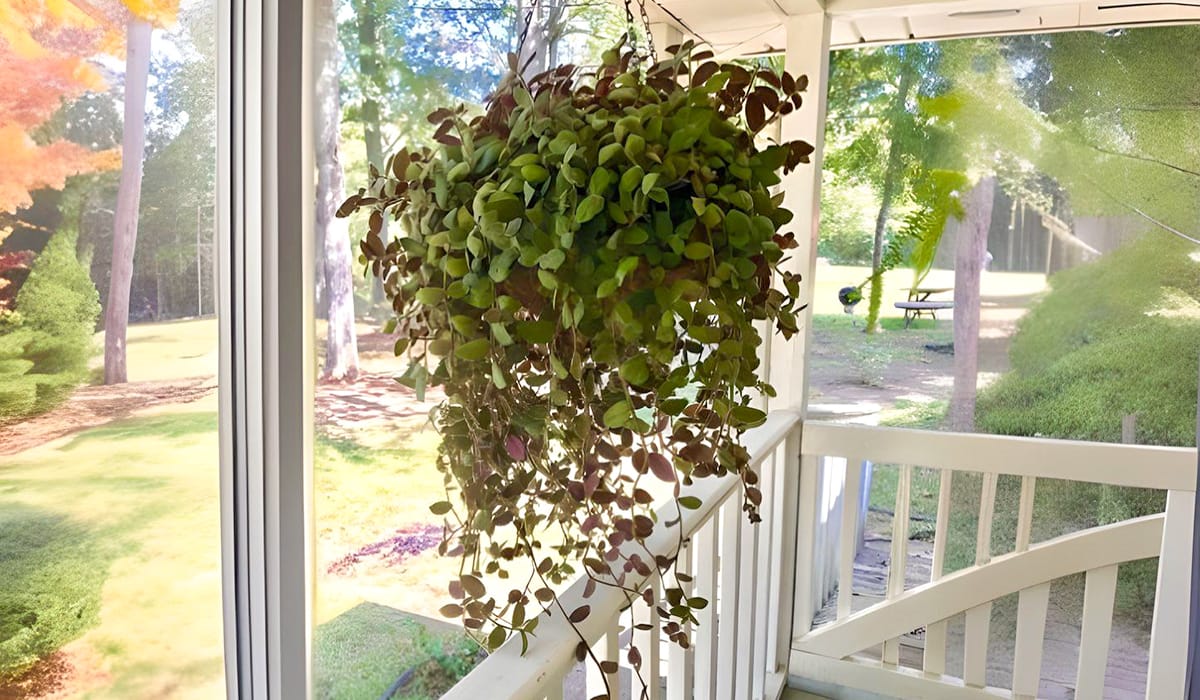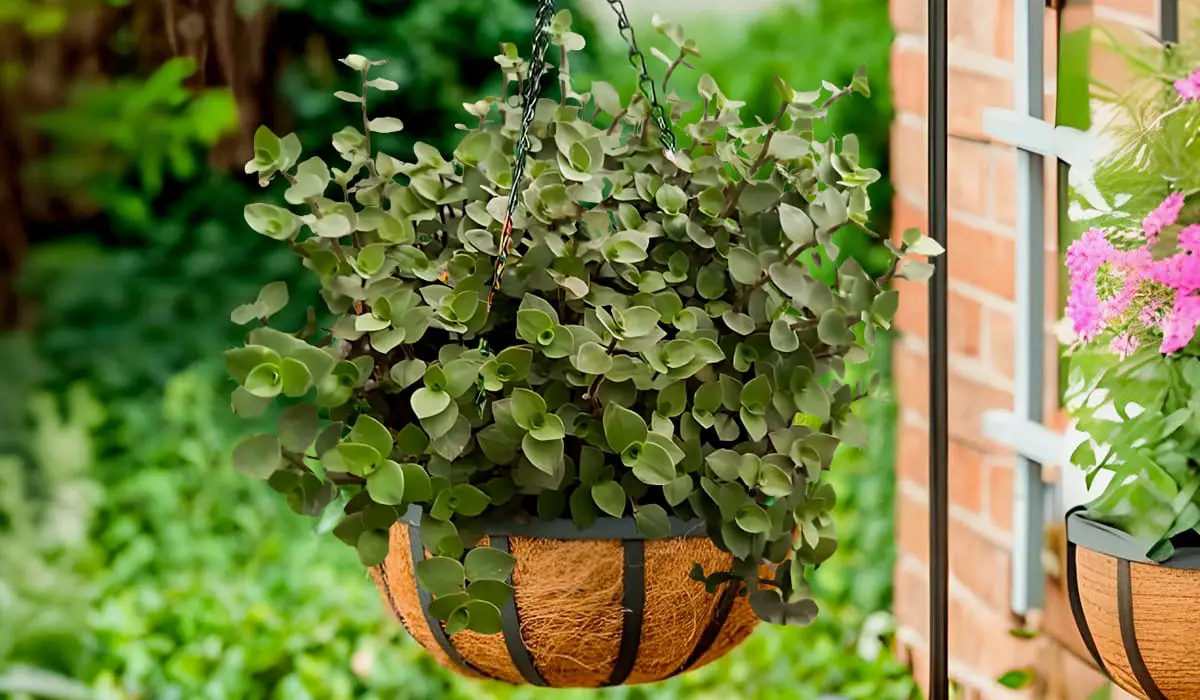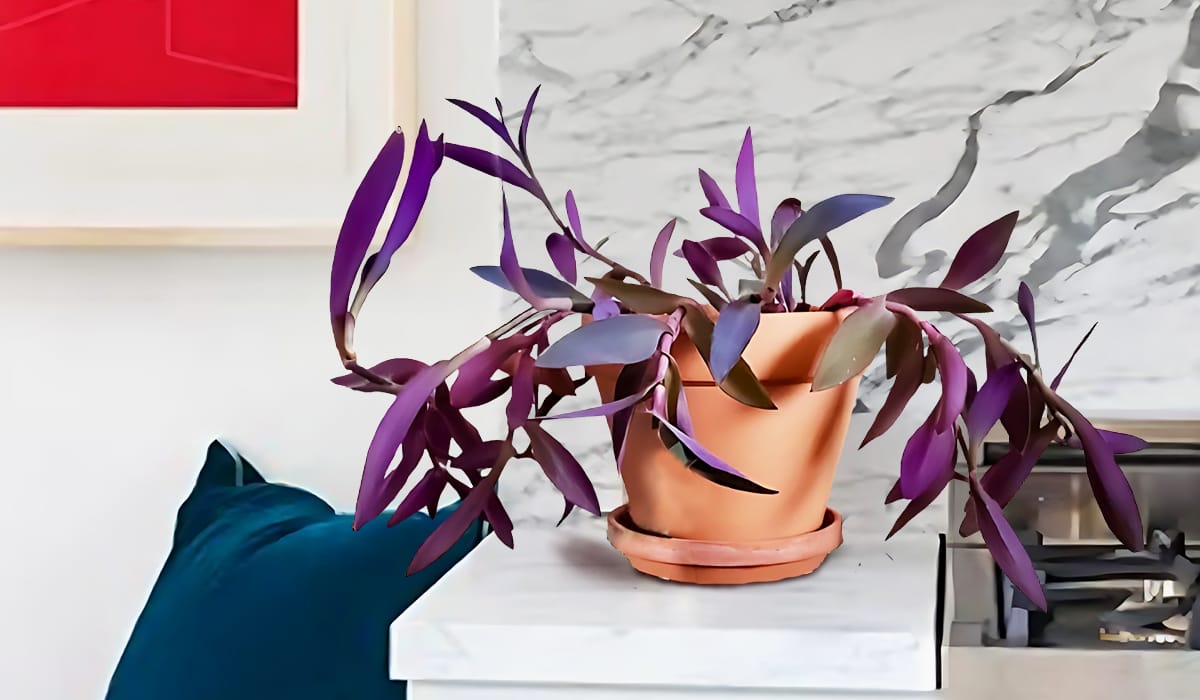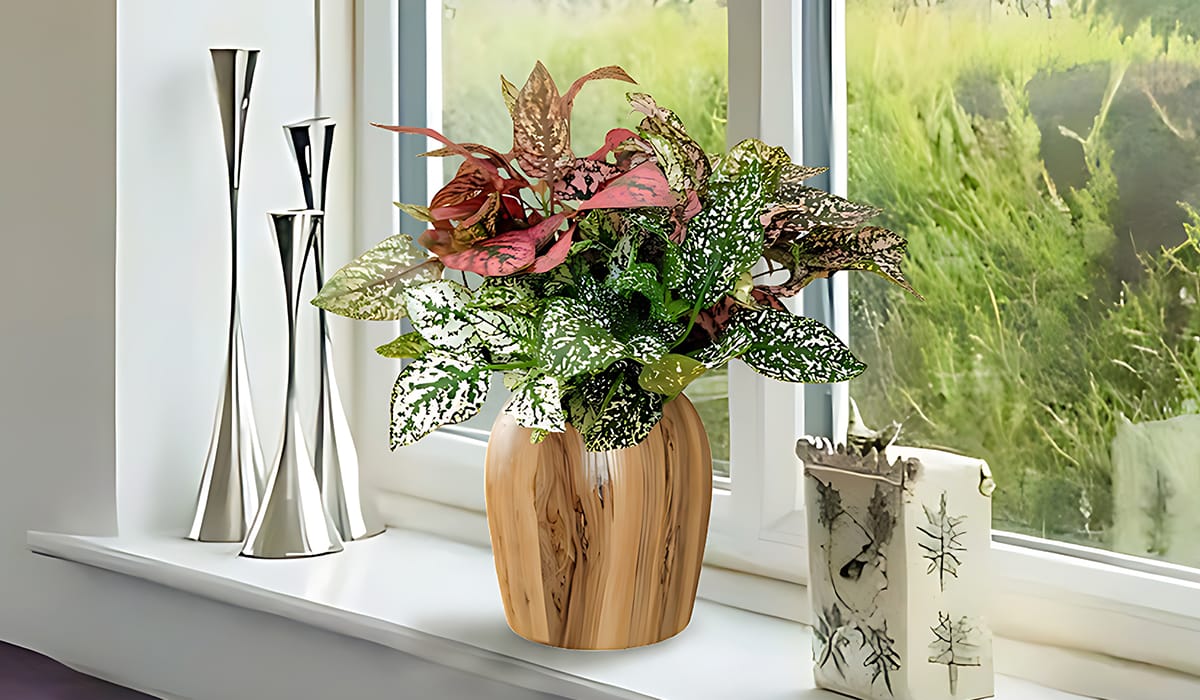Are you looking a good Spider Plants and if You searching, how to plant, grow, and care for Spider Plants?
Great You have come to one of the best resources available on the internet.
We researched several books, blogs, and videos about the Spider Plant and added our personal experiences then we wrote this article. If you read this full article properly. Then you will get a complete idea of the Spider Plants and care for them. So if you are a plant lover we hope you will enjoy this article.
let's Introduce
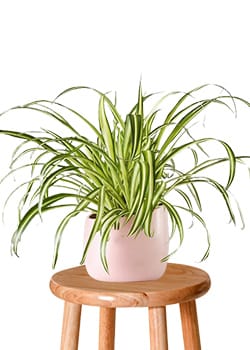
Spider Plants
Known for their showy green and white striped leaves, spider plants are popular with houseplant lovers. Not only are they visually appealing, they are also extremely easy to care for. In this comprehensive guide, we delve into the world of spider plant care and provide valuable information and tips to help you ensure spider plants thrive in your home.
| Common Name: | Spider Plant |
| Botanical Name: | Chlorophytum comosum |
| Height: | Spider plants typically grow to a height of about 12 to 18 inches (30 to 45 cm). However, their long, arching leaves can extend up to 2 feet (60 cm) or more in length. |
| Tolerate: | Spider plants are known for their ability to tolerate a wide range of conditions, making them suitable for various indoor environments. They can withstand low light, but they thrive in bright, indirect sunlight. |
| Plant Type: | Spider plants are herbaceous perennials, often grown as indoor houseplants. They are known for their attractive foliage. |
| Family: | Asparagaceae |
| Sun Exposure: | Spider plants prefer bright, indirect sunlight but can tolerate lower light conditions. They should be protected from direct sunlight, which can scorch their leaves. |
| Mature Size: | Mature spider plants can have a spread of up to 2 to 3 feet (60 to 90 cm) and a height of 12 to 18 inches (30 to 45 cm). The long, arching leaves give them a graceful appearance. |
| Soil pH: | Spider plants prefer slightly acidic to neutral soil with a pH range between 6.0 to 7.0. They are adaptable and can tolerate a broader pH range, but maintaining slightly acidic soil is ideal. |
| Soil Type: | Spider plants thrive in well-draining potting mixes. A mix of potting soil and perlite or sand is suitable for promoting proper drainage and preventing waterlogging. |
| Flower Color: | Spider plant flowers are small and typically white with greenish-yellow centers. |
| Bloom Time: | Spider plants can produce flowers in the spring and summer months. However, indoor plants may not always bloom, and the primary attraction is their foliage. |
| Native Area: | Spider plants are native to South Africa, where they grow in subtropical and tropical regions. |
| Toxicity: | Spider plants are considered safe for pets and humans. They are non-toxic and can be an excellent choice for households with pets or small children. |
| Hardiness Zones: | Spider plants are typically grown as indoor houseplants. However, if you live in a climate with mild winters, you can grow them outdoors in USDA hardiness zones 9 to 11. In colder regions, they are best kept indoors during the winter months or treated as annuals in outdoor gardens. |
Popular for their free-living nature and striking appearance, spider plants are a popular choice for indoor gardening. Their air-purifying properties, low maintenance, and adaptability make them a great addition to any home or office.
How To Propagate Spider Plant

Spider plants (Chlorophytum comosum) are recounted for their ease of propagation. You can propagate spider plants through several methods, including:
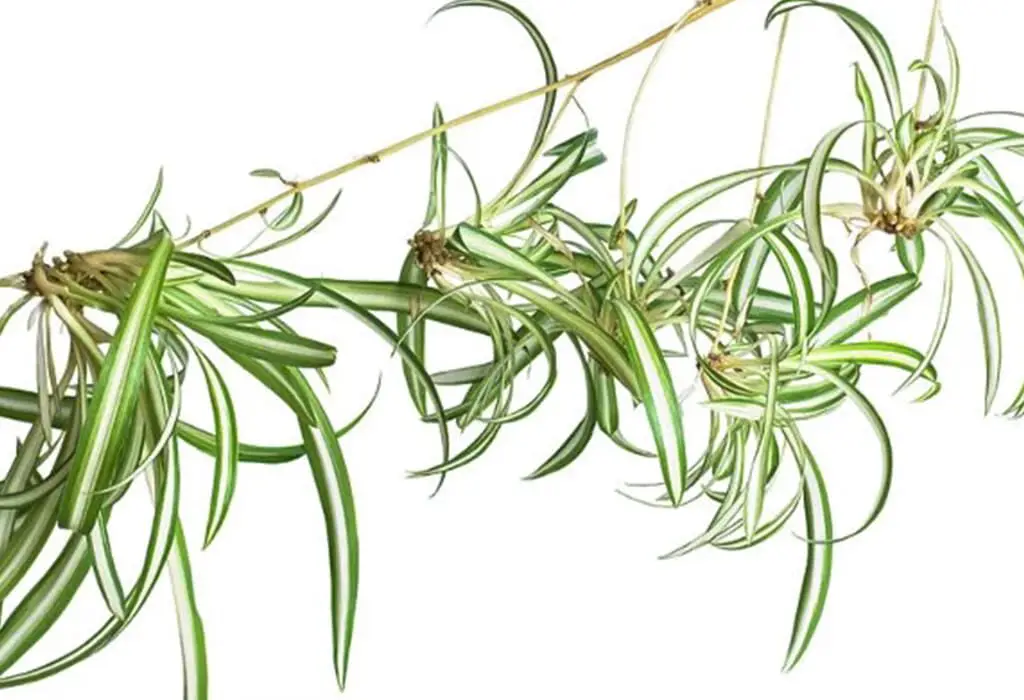
- Offsets (Pups): This is the most common and easiest way to propagate spider plants. Follow these steps:
- Locate the offsets or "pups." These are small plantlets that develop at the bottom of the mature spider plant, typically related to the principle plant through a stem.
- Gently cast off the offset from the precept plant. You can use your fingers or a sharp, clean knife or scissors.
- Plant the offset in a small pot with sparkling potting soil. Ensure that the offset is buried just deep enough to cover its roots. Water it lightly.
- Place the potted offset in indirect sunlight, and keep the soil consistently moist, but not soggy. After a few weeks, it should develop its root system and start growing.
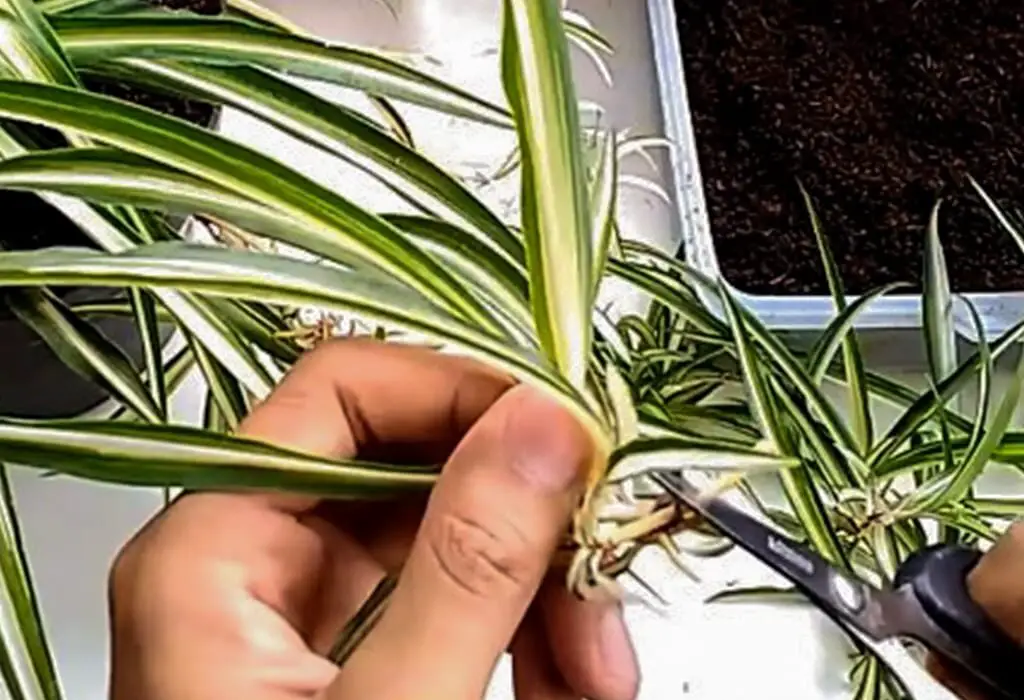
2. Stem Cuttings: You can also propagate spider plants from stem cuttings. Here's how:
- Select a healthy spider plant and cut a section of a mature stem. Make sure the cutting is at least 3-4 inches long and has a few healthy leaves.
- Allow the cut end to dry for a few hours. This helps prevent rotting when you plant it.
- Plant the cutting in a small pot with fresh potting soil, burying it about an inch deep. Water it lightly.
- Place the potted cutting in indirect sunlight and keep the soil consistently moist. It should start developing roots and new growth in a few weeks.
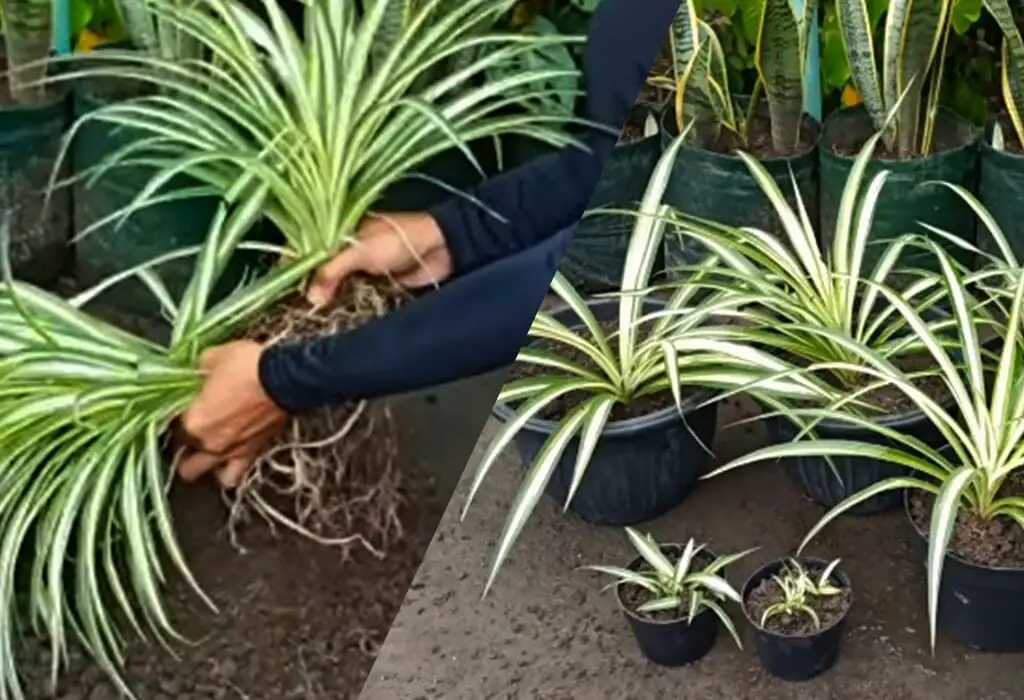
3. Division: If your spider plant has become large and overcrowded, you can divide it to create new plants. Here's how:
- Carefully remove the entire plant from its pot and shake off excess soil.
- Gently tease apart the root ball into smaller sections, making sure each section has both roots and foliage.
- Plant those divided sections in separate pots with sparkling potting soil.
- Water the newly potted divisions and area them in oblique sunlight. Keep the soil consistently moist until they establish themselves.
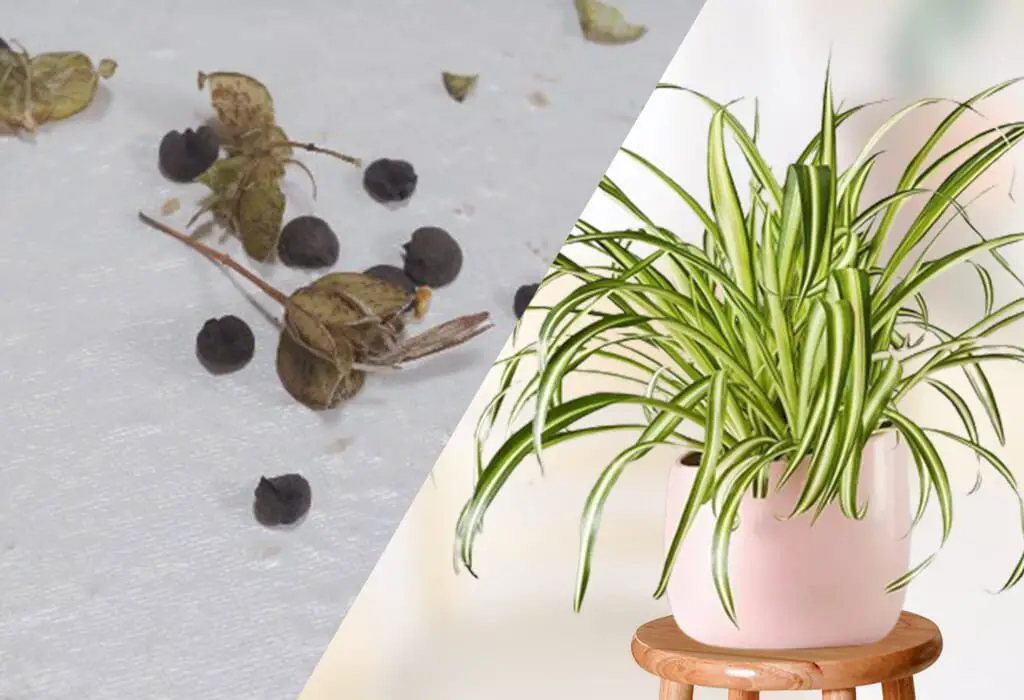
4. Seeds: Spider plants can also be grown from seeds, although this method is less common. Here's how:
- Collect seeds from mature spider plant flower stalks.
- Plant the seeds in a pot with a well-draining potting mix, simply slightly masking them with soil.
- Keep the soil continuously wet and area the pot in a warm, oblique daylight location.
- Germination can take several weeks to months. Once the seedlings have grown large enough, you can transplant them into separate pots.
Spider plants are quite resilient, and with proper care, your propagated plants should thrive. Remember to avoid direct sunlight, water them moderately, and provide good drainage for the soil.
BUY ONLINE PLANT POT
Spider Plant Care Tips
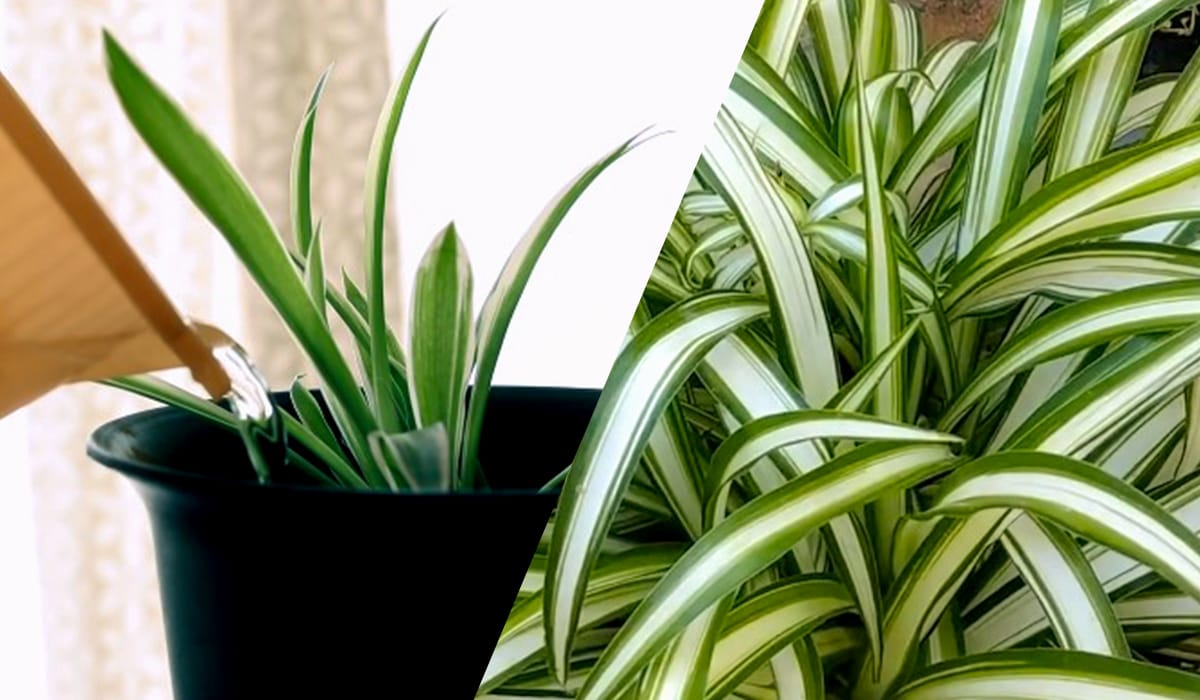
Caring for a Spider Plant (Chlorophytum comosum) is relatively easy, making it a perfect choice for both beginners and experienced plant enthusiasts. Here's a detailed guide on how to care for your Spider Plant:
1. Light Requirements:
- Spider plants thrive in bright, indirect sunlight. Place them near a north or east-facing window, where they can receive filtered sunlight throughout the day.
- They can tolerate low light conditions but may not grow as vigorously or produce as many offsets (baby plants) in lower light.
2. Temperature and Humidity:
- Spider flowers are adaptable to a variety of temperatures. Ideally, keep them in a room with temperatures between 65°F to 75°F (18°C to 24°C).
- They can tolerate slightly cooler temperatures but should be protected from drafts and sudden temperature drops.
- Spider plants do well in moderate indoor humidity levels and do not require extra humidity. However, misting occasionally can be beneficial in dry indoor environments.
3. Watering Routine:
- Allow the top inch (2.5 cm) of the soil to dry out after watering. Stick your finger into the soil; if it feels dry at the top, it's time to water.
- Water thoroughly, ensuring that excess water drains from the pot. Spider plants are susceptible to root rot, so avoid letting them sit in standing water.
- During the growing season (spring and summer), increase the frequency of watering, but still, maintain the "let it dry slightly" rule.
4. Container Selection:
- Choose a pot with drainage holes to prevent overwatering. Well-draining soil is critical for Spider Plants.
- If your Spider Plant outgrows its pot or becomes root-bound, consider repotting it into a slightly larger container.
5. Soil Type:
- Spider vegetation thrives in a well-draining potting mix. A mixture of regular potting soil and perlite or sand works well to ensure good drainage.
6. Fertilization:
- Feed your Spider Plant with a balanced liquid fertilizer every 2-4 weeks during the growing season (spring and summer). Use a diluted, half-strength fertilizer to avoid over-fertilization.
- Reduce or stop fertilizing during the winter months when the plant's growth slows down.
7. Pruning and Maintenance:
- Trim brown or yellowing leaves regularly to maintain the plant's appearance.
- Remove any offsets (baby plants) that grow on long runners. These can be potted separately to grow new plants.
8. Propagation:
- Spider plants are easily propagated by dividing the offsets. Simply detach the baby plants from the parent plant and pot them separately.
9. Pest Control:
- Spider flowers are usually proof against pests. However, occasionally, you may encounter spider mites or mealybugs. Treat infestations with neem oil or insecticidal soap.
10. Pet and Child Safety:
- Spider plants are non-toxic and safe for both pets and children, making them an excellent choice for households with these potential hazards.
11. Repotting:
- Spider plants may need repotting every 2-3 years or when they become root-bound. Choose a barely large pot and clean the potting blend while repotting.
By following these detailed care instructions, you can ensure that your Spider Plant remains healthy, and vibrant, and continues to produce its characteristic arching leaves and baby plants. Remember that Spider Plants are forgiving and can adapt to a variety of conditions, making them an excellent addition to your indoor plant collection.
BUY ONLINE POTTING SOIL
Spider Plant varieties
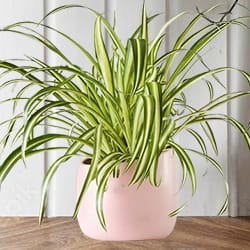
| 1. Chlorophytum comosum (Classic Spider Plant): |
|---|
| This is the maximum not unusualplace kind of spider plant, presenting long, arching inexperienced leaves with white stripes alongside the edges. It's often referred to as the "Airplane Plant" or "Ribbon Plant." |
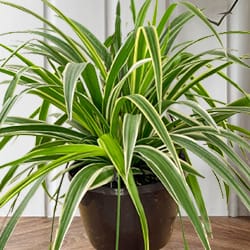
| 2. Variegated Spider Plant: |
|---|
| Variegated spider plants have the same basic appearance as the classic variety but with broader white stripes on the leaves, creating a more pronounced variegation. |
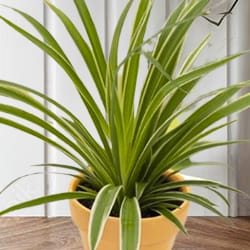
| 3. Reverse Variegated Spider Plant: |
|---|
| In this variety, the leaves are primarily green with narrow white stripes along the edges, which is the reverse of the classic pattern. |
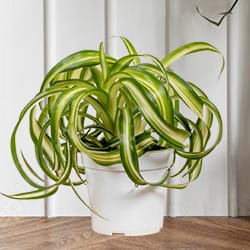
| 4. Bonnie Spider Plant: |
|---|
| The Bonnie spider plant is a compact variety with shorter leaves that retain the classic green and white stripes. |
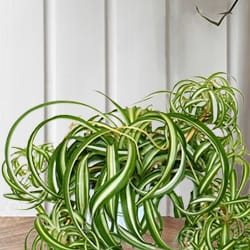
| 5. Curly Spider Plant: |
|---|
| Curly spider plants have distinctive twisted or curly leaves, adding an intriguing texture to their appearance. |

| 6. Hawaiian Spider Plant: |
|---|
| This variety has green leaves with a central pink stripe, providing a vibrant and eye-catching contrast. |
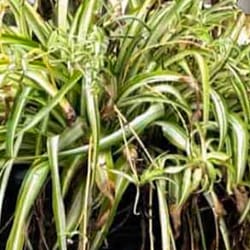
| 7. Milky Way Spider Plant: |
|---|
| Milky Way spider plants have a similar appearance to the classic variety but with more pronounced white variegation, resembling a "milky way" of white streaks. |
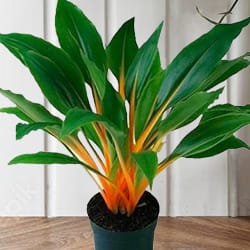
| 8. Fire Flash Spider Plant: |
|---|
| Fire Flash spider plants feature green leaves with vibrant red or pink edges, creating a striking and colorful contrast. |
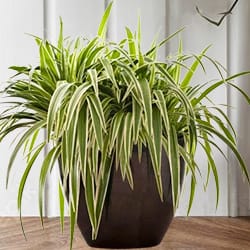
| 9. Zebra Grass Spider Plant: |
|---|
| Zebra Grass spider plants have dark green leaves with white stripes, giving them a zebra-like appearance. |
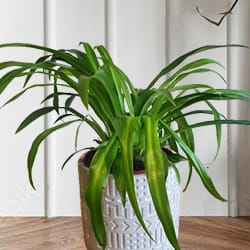
| 10. Lemon Spider Plant: |
|---|
| Lemon spider plants have bright green leaves with a lemony-yellow central stripe, adding a cheerful touch to their appearance. |
Common Problems with Spider Plant: And Solution
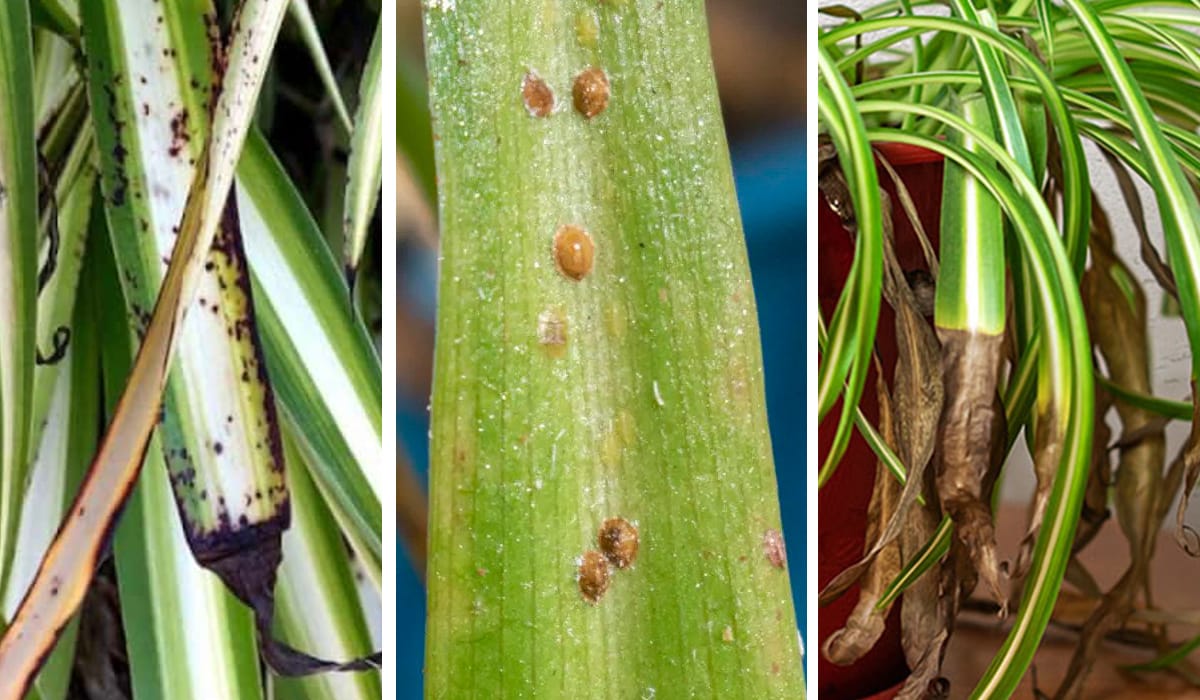
Spider plants (Chlorophytum comosum) are popular indoor houseplants known for their easy care and air-purifying qualities. However, like all houseplants, they can encounter some common problems. Here are several common issues that spider plant owners may face and their solutions:
1. Brown Tips on Leaves:
- Problem: Brown tips on spider plant leaves are often caused by excessive fluoride in the water or low humidity levels.
- Solution: Use distilled water or let tap water sit out overnight to allow chlorine and fluoride to dissipate. Increase humidity by misting the plant or using a humidifier.
2. Yellow Leaves:
- Problem: Yellowing leaves can result from overwatering, underwatering, or poor soil drainage.
- Solution: Adjust your watering routine. Ensure the soil is well-draining and water the plant when the top inch of soil feels dry to the touch.
3. Root Rot:
- Problem: Overwatering or poor drainage can lead to root rot, which can cause wilting and yellowing of leaves.
- Solution: Trim away affected roots, repot the plant in well-draining soil, and reduce watering. Make sure the pot has drainage holes.
4. Small or Stunted Growth:
- Problem: Spider plants may not grow well if they are root-bound or lack nutrients.
- Solution: Repot the plant into a slightly larger pot if it's root-bound. Fertilize during the growing season with a balanced, diluted houseplant fertilizer according to package instructions.
5. Drooping Leaves:
- Problem: Overwatering or underwatering can cause the leaves to droop.
- Solution: Adjust your watering routine as needed to maintain consistent moisture levels in the soil. Be sure to allow excess water to drain away.
6. Pests:
- Problem: Spider plants can attract pests like spider mites, mealybugs, and aphids.
- Solution: Inspect your plant regularly for signs of pests and take appropriate action. Isolate the plant if an infestation is severe. Use insecticidal soap or neem oil to treat pests, following the instructions on the product label.
7. Faded Leaf Color:
- Problem: Insufficient light can lead to faded or pale leaves.
- Solution: Place your spider plant in bright, indirect sunlight. Avoid direct sunlight, which can scorch the leaves. Rotate the plant occasionally to ensure even growth.
8. Leggy Growth:
- Problem: Spider plants may become leggy (long stems with few leaves) if they don't receive enough light.
- Solution: Move the plant to a brighter location to encourage more compact growth. Prune leggy stems to promote bushier growth.
9. Lack of Pups (Offsets):
- Problem: Spider plants typically produce offsets or pups. If your plant isn't producing them, it may be due to stress, lack of nutrients, or insufficient light.
- Solution: Ensure your plant is in optimal conditions, including proper light, watering, and fertilization. Pups can be separated from the parent plant and potted independently once they reach a reasonable size.
10. Wilting After Repotting:
- Problem: Spider plants can go through a period of shock after repotting, causing wilting.
- Solution: Be patient. Keep the plant in its new pot with proper care, and it should recover in a few weeks as it adjusts to its new environment.
By addressing these common issues and providing proper care, you can help your spider plant thrive and maintain its vibrant green foliage.
Spider Plants Benefits
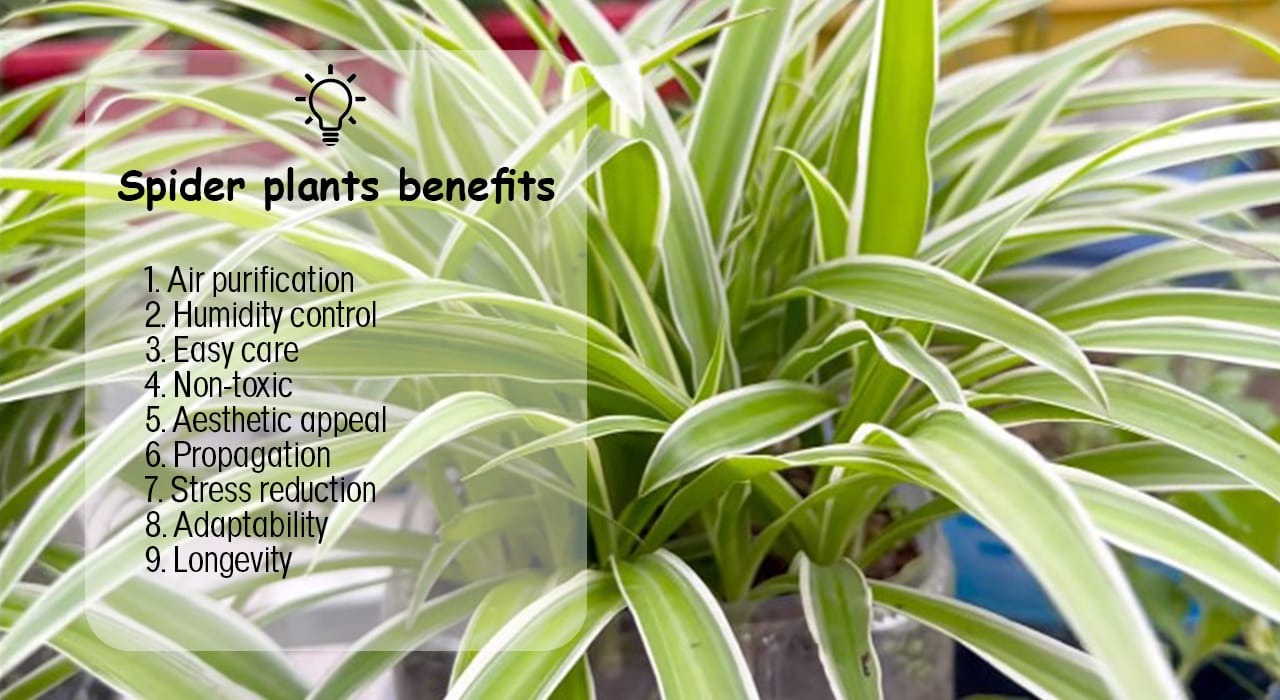
Spider plants (Chlorophytum comosum) are famous houseplants recognized for his or her unique arching leaves and simplicity of care. They offer several benefits when grown indoors:
| 1. Air purification: | Spider plant life are notable air purifier. They can do away with not unusual indoor pollution along with formaldehyde and xylene, supporting to enhance indoor air quality. This makes them a great choice for homes and offices. |
| 2. Humidity control: | Spider plant life launches moisture into the air through a method referred to as transpiration. This can help increase the humidity in a room, making it more comfortable for people, especially during dry winter months or in air-conditioned spaces. |
| 3. Easy care: | Spider plants are low-maintenance and forgiving, making them ideal for beginner gardeners. They can tolerate a range of light conditions and are relatively drought-resistant. |
| 4. Non-toxic: | Spider plants are safe for pets, including cats and dogs, making them a pet-friendly choice for households. |
| 5. Aesthetic appeal: | Their long, arching leaves and attractive variegated foliage make spider plants visually appealing, adding a decorative element to your living space. |
| 6. Propagation: | Spider plants produce "pups" or baby plants that can be easily propagated and shared with others. This makes them a great plant for gifting or expanding your indoor garden. |
| 7. Stress reduction: | Like many houseplants, caring for a spider plant can be therapeutic and reduce stress. The act of nurturing a living plant and watching it grow can be rewarding and calming. |
| 8. Adaptability: | Spider plants can adapt to different lighting conditions, although they thrive in bright, indirect light. They can tolerate occasional low mild conditions, making them appropriate for diverse components of your own home or office. |
| 9. Longevity: | With the right care, spider flora can stay for lots of years, offering lasting splendor and air-purifying benefits. |
To care for a spider plant, provide it with well-draining soil, water when the top inch of soil is dry, and fertilize occasionally during the growing season. Avoid overwatering, as this could result in root rot. Spider plants are relatively pest-resistant, but you should monitor them for any signs of pests and take appropriate action if necessary. Overall, spider plants are a wonderful addition to any indoor space, offering both aesthetic and health benefits.
FAQ
Where is the best place to put a spider plant?
Should I cut the babies off my spider plant?
How do I take care of a spider plant?
Water when the top inch of soil is dry, but avoid overwatering, as it can lead to root rot.
Use well-draining potting soil.
Provide bright, indirect light.
Fertilize sparingly during the growing season (spring and summer) with a balanced, diluted liquid fertilizer.
Maintain a comfortable room temperature between 65-75°F (18-24°C).
Prune away brown or yellowing leaves as needed.
Is a spider plant a good houseplant?
Should I cut the brown tips off my spider plant?
wrapping up
Caring for a spider plant is a rewarding experience that adds beauty and vitality to your indoor space. By providing the right conditions and following the tips outlined in this guide, you'll have a flourishing spider plant that enhances your home's ambiance and air quality. So, go ahead and embrace the world of spider plant care, and watch your green friend thrive. Remember, spider plant care is not just about nurturing a houseplant; it's about cultivating a connection with nature within the comfort of your own home. Happy spider plant parenting!
Thanks for reading this article. if you have any questions must comment and contact our team.

